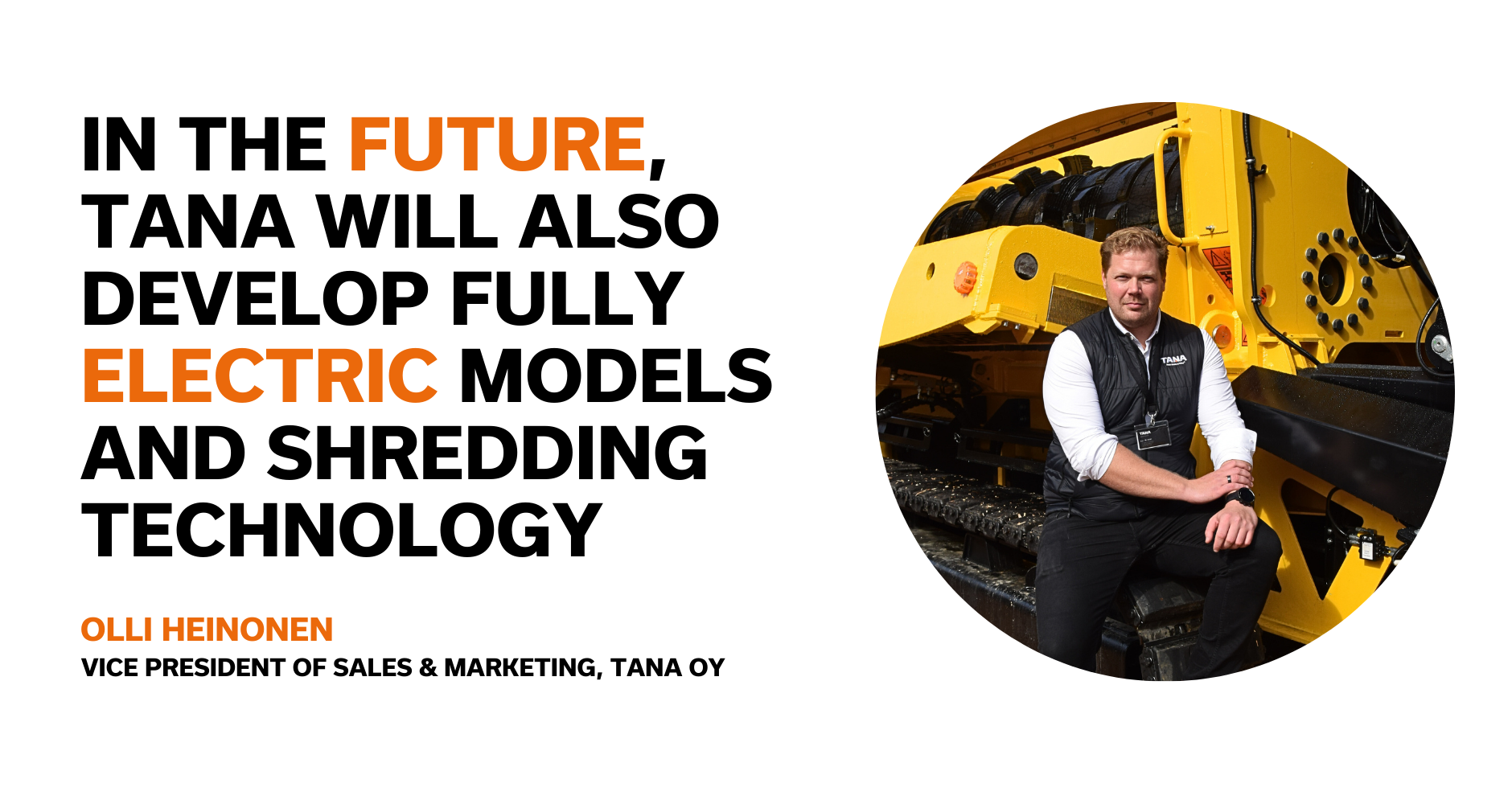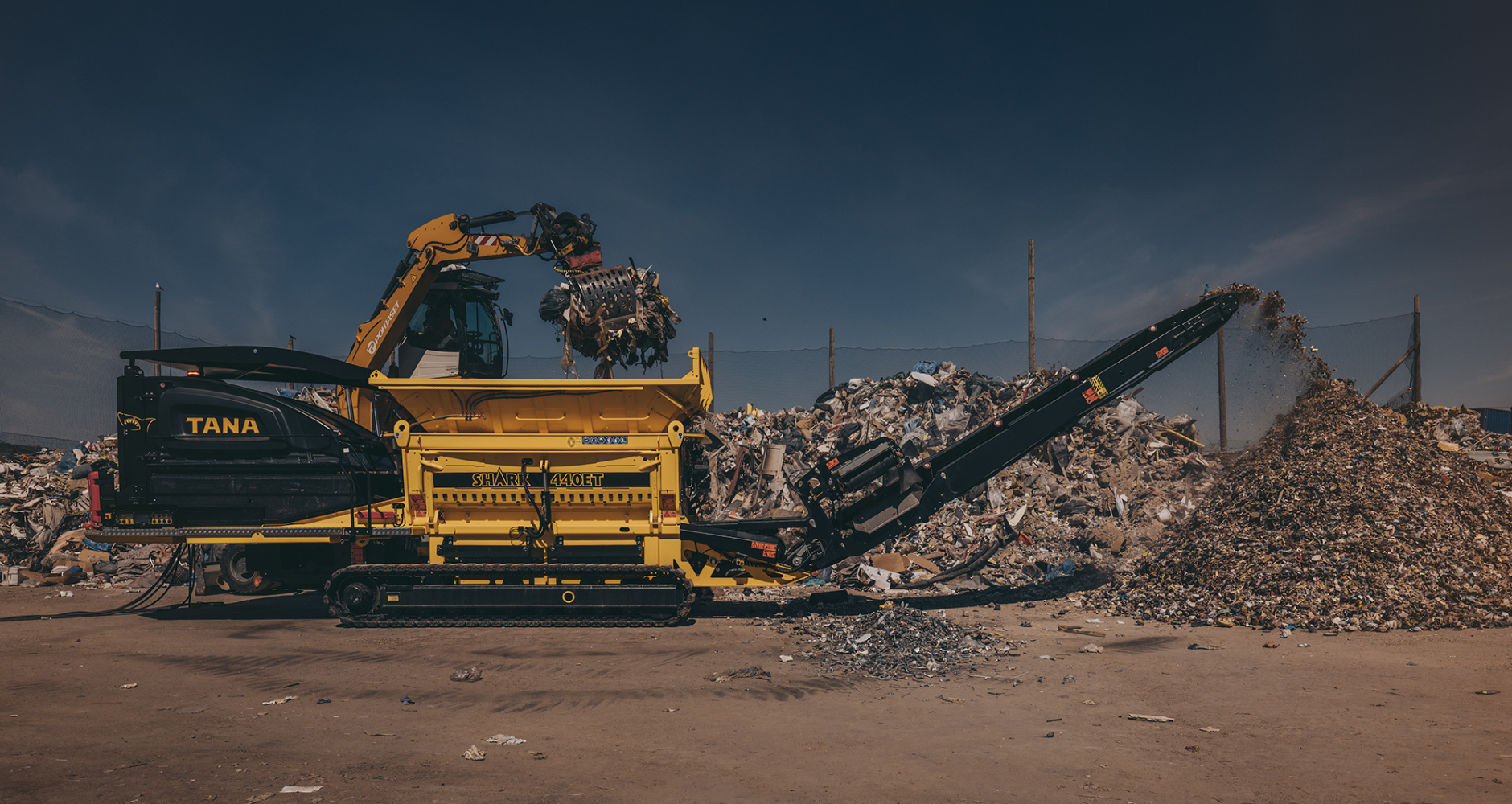The trend towards electrification is advancing unstoppably even in industrial machinery – including TANA waste shredders. We have already sold our first electric shredders, and more have been ordered.
At the beginning of September, Tana launched an electric shredder that runs on tracks at the Maxpo exhibition. Development continues, and more electric models are on the way.
“In the future, Tana will also develop fully electric models and shredding technology. The biggest change in the electrification of our waste shredders is being made here and now. It is no longer just a question of future plans. The trend can also be seen in the rapidly growing demand for electric machinery,” says Olli Heinonen, Vice President, Sales & Marketing, at Tana.
Mobile electric waste shredder now also available
This September, Tana launched the first waste shredder model on the market that combines mobility and electric drive. The electric shredder, which runs on tracks, was presented to Tana’s dealers for the first time in June and exhibited at Maxpo in September. The new model has already attracted a lot of interest, and the first mobile electric shredders will be delivered to customers in early 2024.
The TANA Shark 440ET electric shredder features tracks and a small auxiliary diesel engine for efficient mobility but shreds waste using electricity, which combines the benefits of low costs and low noise levels. The electric motor operates the hydraulic pump, which powers the entire shredding process, including spinning the rotor knives.
“With our electric shredders, customers get two birds with one stone in the form of both financial and environmental benefits. Considering the number of enquiries that we’ve received in such a short time, it’s clear that electrification is a subject of interest among our customers.”
According to Heinonen, interest has been stimulated not only by the launch of the new model, but also by high fuel costs and everything else that is happening in the economy. Electricity is still reasonably priced compared to diesel and will certainly be significantly cheaper in the longer term.
“By switching to electricity, customers can reduce their operating costs and achieve really significant savings. However, it requires that their infrastructure is in good condition in terms of electricity supply and having sufficiently large main fuses. This can be a challenge for some companies in the industry, but very many circular economy companies have good electrical connections already in place or there are other industries that require electricity in the same areas of operation, so this has not been a problem,” says Heinonen.
Electrification is progressing and savings can be generated, even when electricity is not cheap
The electrification of TANA waste shredders and industrial machinery in general is of interest to customers, retailers and other stakeholders for many reasons. For example, electrification effectively reduces carbon dioxide emissions and noise levels in the surrounding environment. Tighter regulations related to environmental impacts, as well as affordable energy, are also having an effect. Even when electricity is not cheap, a machine that uses electricity as its power source can still generate savings and enable operations with clearly lower carbon dioxide emissions.
“Electricity is the key advantage of our machine by enabling CO2-free operation. Electricity doesn’t even have to be extremely cheap – more important is that the electricity is clean.”
Operating costs are also reduced due to the long maintenance intervals and simpler maintenance of electric machines. In addition, the service life of electric motors is longer than that of combustion engines, and using them is also safer, since the motor does not heat up in the same way. Also, electric industrial machines do not use battery packs, which have posed fire risks in passenger cars. Above all, electric operation increases competitiveness and responds to global sustainability challenges.
“In many cases, machine manufacturers see electrification in the short term. Feedback from small businesses can easily be dismissive, but the situation can turn around quickly when electricity is cheap. Electricity is the key advantage of our machine by enabling CO2-free operation. Electricity doesn’t even have to be extremely cheap – more important is that the electricity is clean,” says Tana CEO Kalle Saarimaa.
“We have already sold our first electric shredders, and more have been ordered. In ten years, we will certainly sell more electric machines than diesel machines,” Saarimaa continues.
Clean electricity is decisive
In terms of the climate and the environment, however, the biggest impacts are not achieved by electrifying waste shredders, which mainly has local impacts, as significant as they may be for residents in the surrounding area. Wider impacts are achieved through the choice of energy and how cleanly the electricity is produced. If it is produced by burning fossil fuels, the benefit will be smaller. Also decisive is the so-called ecological handprint of the waste shredders – in other words, what are their broader impacts among other actors as enablers of the circular economy and sustainable development.
“Industrial side streams can produce a lot of non-uniform and difficult-to-handle waste, such as waste from the paper industry, waste from sandpaper factories or even fishing nets. When volumes and waste flows are also large, Tana’s handprint is more visible by handling waste in a modern way. We offer such a multipurpose waste shredder that it enables efficient and sensible waste processing and reuse,” says Heinonen.
Circular economy needs electric shredders, but electrification of landfill compactors still has to wait
According to Heinonen, whether the waste taken to landfills is compacted by a diesel-powered or an electric compactor is not such an issue in terms of emissions. The bigger problems to be solved are whether the waste can be separated, processed, recycled and reused. After all, the global goal is to prevent the generation of new waste and avoid the need to establish new landfills.
“During the transition to a circular economy, an efficient and controlled landfill is of course better than not processing waste at all. TANA landfill compactors are typically around ten percent more efficient than other machines, which extends the lifespan of landfills and similarly reduces the need to establish new ones,” Heinonen points out.
“Some people compare landfill compactors to bulldozers, which are still used in some markets, but they do not compact waste nearly as efficiently,” he adds.
Using a shredder, waste can be processed in one place and transported on tracks or in a container from one waste pile to another or to the maintenance area. The fact that the waste has to be transported short distances at most has allowed Tana to begin electrifying its shredders. Waste compactors, on the other hand, are used in motion, which poses its own challenges.
“Electrifying massive machines like waste compactors is much more challenging due to their operating environment, so we are investigating alternative energy sources for our compactors. Electric compactors would either need a ridiculously large and expensive battery pack or be charged so frequently that a complex charging infrastructure would also have to be built,” Olli Heinonen explains.
Waste shredders, by comparison, are operated for several hours at a time at the end of the waste piles, so battery technology is not needed. Their operating cycles are long.
According to CEO Kalle Saarimaa, Tana aims to cover the entire global market. On the global scale, even landfill compactors protect biodiversity and reduce the need to establish new landfills. Nevertheless, he does not refer to compactors as a product of the future, but rather “an optimisation of the linear economy”.
“This year, waste compactors have accounted for the majority of our global sales, but we are starting to shift more to shredders, perhaps 60:40,” says Saarimaa.

